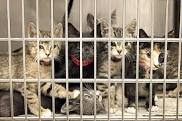Treatment of upper respiratory infections in housed cats
Objective—To compare efficacy of amoxicillin-clavulanic acid, cefovecin, and doxycycline in shelter-housed cats with clinical signs of upper respiratory tract disease (URTD). Design—Randomized prospective clinical trial. Animals—48 cats with URTD.
Procedures—Conjunctival and nasal swab specimens were obtained for culture and susceptibility testing, and cats were randomly assigned to 3 treatment groups (16 cats/group) on day 1: amoxicillin-clavulanic acid (12.5 mg/kg [5.68 mg/lb], PO, q 12 h, for 14 days), cefovecin (8.0 mg/kg [3.64 mg/lb], SC, once), or doxycycline (10.0 mg/kg [4.55 mg/lb], PO, q 24 h, for 14 days). Oculonasal discharge, sneezing, coughing, dyspnea, demeanor, and food intake were scored twice daily for 14 days (scale, 0 [subjectively normal] to 3 [markedly abnormal]).
Results—The most common bacterial isolates were Mycoplasma spp (n = 22) and Bordetella bronchiseptica (9). Cats treated with amoxicillin-clavulanic acid or doxycycline had significantly increased body weight by day 14. Cats that received doxycycline had significantly lower overall oculonasal discharge scores than those treated with amoxicillin-clavulanic acid or cefovecin. Cats treated with amoxicillin-clavulanic acid or doxycycline had significantly lower overall sneezing scores than those that received cefovecin. Cats that received amoxicillin-clavulanic acid had significantly decreased demeanor and food intake scores on day 2, whereas this was detected later in other groups (demeanor score on days 5 and 7 and food intake score on days 10 and 11 in the cefovecin and doxycycline groups, respectively).
Conclusions and Clinical Relevance—Oral administration of amoxicillin-clavulanic acid or doxycycline appeared to be more effective than a single SC injection of cefovecin in treating cats with clinical signs of URTD. (J Am Vet Med Assoc 2012;241:218–226)
Click here to be directed to the full study.

